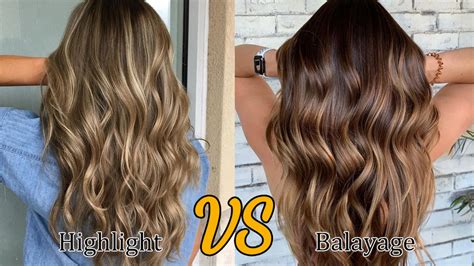Introduction
When it comes to enhancing hair color, two popular techniques often come to mind: highlights and balayage. Both techniques involve lightening hair, but they offer distinct results. This article provides an in-depth comparison of highlights and balayage, addressing their differences, benefits, and intended effects.

Technique and Appearance
Highlights
- Technique: Highlights are achieved by selecting specific sections of hair and applying a lightener. These sections are usually small and evenly distributed throughout the head.
- Appearance: Highlights create a more traditional, defined look with clear lines of demarcation between the lightened and natural hair.
Balayage
- Technique: Balayage is a freehand painting technique where lightener is applied to the surface of the hair, typically starting from the mid-lengths to the ends.
- Appearance: Balayage creates a more natural, blended look with a gradual transition from light to dark tones.
Differences at a Glance
| Feature | Highlights | Balayage |
|---|---|---|
| Technique | Precise sectioning | Freehand painting |
| Appearance | Defined lines of demarcation | Blended, gradual transition |
| Coverage | Even distribution | Concentrated on mid-lengths to ends |
| Maintenance | Requires regular touch-ups | Less frequent maintenance |
Benefits and Drawbacks
Highlights
Benefits:
- Precise and defined results: Suitable for creating bold or dramatic effects.
- Can add depth and dimension: Enhances texture and body in fine or flat hair.
- Easier to repair: Any unevenness or unwanted tones can be easily corrected.
Drawbacks:
- Can look unnatural if not done professionally: Requires precise placement and application.
- Requires frequent touch-ups: To maintain the desired contrast and prevent brassiness.
- Can damage hair if over-processed: Bleaching can weaken the hair shaft, leading to breakage.
Balayage
Benefits:
- Natural and low-maintenance: Requires less frequent touch-ups as the roots grow out.
- Versatile: Can be customized to suit different hair textures and colors.
- Adds warmth and shine: Enhances the overall color and texture of hair.
Drawbacks:
- Can be time-consuming: The freehand painting technique may take longer than highlights.
- May not be suitable for all hair types: Not recommended for extremely dark or fine hair.
- Can be difficult to achieve even results: Requires a high level of skill and experience.
Which Technique is Right for You?
The best technique for you depends on your specific hair type, desired look, and lifestyle.
Highlights:
- Ideal for those seeking a dramatic or defined color change.
- Suitable for both short and long hair.
- Requires more frequent maintenance.
Balayage:
- Perfect for a subtle, natural-looking enhancement.
- Ideal for long or medium-length hair with dark roots.
- Requires less frequent maintenance.
Cost and Time Considerations
- Highlights: Typically cost more and take longer due to the precision required.
- Balayage: Generally less expensive and time-consuming as it involves a more blended approach.
Tips for Choosing a Technique
- Consult with a professional stylist: They can assess your hair and recommend the best technique for your desired outcome.
- Consider your hair type and condition: Fine or damaged hair may not withstand the harsh chemicals involved in highlights.
- Think about your lifestyle: Balayage is a lower-maintenance option for those with busy schedules.
- Research different looks: Browse online portfolios and social media to gather inspiration for your desired result.
Step-by-Step Guide to Balayage
- Section the hair: Divide the hair into four quadrants.
- Paint on lightener: Starting from the mid-lengths, paint the lightener onto the surface of the hair using a brush.
- Blend the sections: Use a comb or brush to gently blend the lightened sections into the natural hair.
- Process the hair: Follow the manufacturer’s instructions for processing the lightener.
- Rinse and condition: Rinse the hair thoroughly and apply a deep conditioner to restore moisture.
Innovative Applications
In addition to traditional highlighting and balayage techniques, innovative applications have emerged to enhance hair color and create unique effects.
- Reverse Balayage: Darkens the mid-lengths to ends while keeping the roots light.
- Shatush: A freehand technique that creates subtle, random highlights with a feathered look.
- Foilayage: Combines highlights and balayage, using foils to protect the natural hair from over-lightening.
- Sombré: A subtle blend of highlights and lowlights, creating a soft and gradual color transition.
Conclusion
Whether you prefer the precise lines of highlights or the natural blend of balayage, there is a hair color technique to suit every style and preference. By understanding the differences, benefits, and limitations of each technique, you can make an informed decision and achieve the desired hair color transformation.
